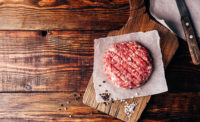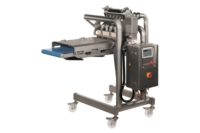The top challenge of forming quality processed meat products is temperature. For example, for a company like Schweid & Sons, in Carlstadt, N.J., when it’s using all fresh whole-muscle meat, it uses nitrogen chilling or CO2 chilling to reduce the temperature of the meat down to about 29 to 31 degrees when the product exits the mixer grinder. The meat is then immediately formed and packaged airtight to maintain the longest shelf life possible and to eliminate bacteria growth in the product.
“When you have meat that is too warm, when it goes into a forming machine or any type of forming equipment, what happens is you get a patty with a tenderness level that is very mushy, and, in many cases, you don’t get a really uniform patty,” says Jamie Schweid, president and CEO of Schweid & Sons. “The reason is, when you’re filling the forming plate with meat that is a little warmer than normal, outside of the critical control points, because it’s not firm it has trouble filling the forming plate and causes a product that probably isn’t performing at its highest standard.”
In addition to temperature, many mid-size processors find themselves handling numerous raw material components. Different raw material components form differently. For example, 15 years ago, a beef processor might handle 75/25, 80/20 and 85/15 ground beef blends. Now, a processor like the St. Michael, Minn.-based J&B Group, which manufactures fresh and frozen ground beef patties for foodservice and 1-pound bricks for retail, makes about 50 different meat recipes. The company produces craft blends, including chuck, ribeye and brisket. The blending also is getting more complex every year, and that is not anticipated to slow down, says Russ Sjoquist, J&B Group vice president of manufacturing.
“We cater to the foodservice industry, and everybody is looking for something that’s a little different,” he explains. “Ground beef patties are a very personal product when it comes to a restaurant operator. They’re very passionate about their ground beef.”
The challenge to forming is that different raw material components form differently. For example, a customer may be using a ground beef blend versus another customer requesting just chuck trim. Each blend will perform different and equipment must be adjusted to make a quality patty.
“You are consistently adjusting your equipment, so that you get a nice product time and time again,” Sjoquist says. “With that temperature is a big piece. You want your meat block about 30 degrees. If it gets warmer than that, your machines won’t work well.”
Schweid & Sons also offers different forming technologies for its customers. “We think that the customer has a right to choose what type of patty and what the attributes of that patty are,” Schweid says.
For example, Schweid & Sons makes a patty called Chef’s Choice, which is a rolled patty that comes out of a forming piece of equipment like a puck or a ball and then rolled into a patty to a certain thickness level.
“The reason we do that is because it’s a looser formed patty,” Schweid says. “It allows for the product to cook quicker, but also it’s a juicer product that air can circulate through the patty more than your standard filled patty.”
Schweid & Sons also offers a traditional patty that goes through a standard forming plate. “The product is a firmer bite, and it has a different texture to it than the Chef’s Choice,” Schweid explains.
The company also offers a tender formed product, which is somewhere in the middle between what a standard filled product is and a Chef’s Choice. “It has a looser bite to it, and a smaller cook time,” Schweid says.
Forming advancements
How do you produce a patty using forming technology at a rate that is fast enough but also maintains superior quality?
“We focus our energies on quality first, making sure that the forming technology is something that our customers will enjoy that creates a better eating experience, but obviously we are a business so we want to make sure that we can make it as efficiently as possible,” Schweid says.
To address multiple changeovers, J&B’s forming equipment is computer controlled. “We have systems in place that can control our production versus allowing the operator to manage all operational controls,” Sjoquist says.
For example, J&B Group’s grinders are computer controlled, so that it doesn’t over mix product or under mix blends, which would affect how a product is formed as well.
“Our goal here is to manage the variables,” says Ben Swinton, J&B’s production manager.
Variables also include shape with some restaurant operators requesting round patties and some requesting plugs where they can smash them down and replicate a hand patty. “There are lots of plate changes both for sizes and for shapes,” Sjoquist says.
In addition, J&B’s customers are beginning to request fresh patties that have inclusions, such as cheese and bacon, which create food safety challenges.
“It compromises the shelf life of the product,” Sjoquist explains. “Doing a frozen product is much easier, but when somebody wants to offer a fresh patty with inclusions, that creates a lot of challenges.”
While the industry is mainly developing forming equipment that caters to large-volume processors, J&B’s equipment is smaller in design with easy changeovers. “It’s all about managing your downtime and changeover time between plates,” Sjoquist says. “…You need machinery that’s flexible, and those are the things we look at when we are looking at equipment.”
Sjoquist says the industry standard is a tender form, tender fill system in patties. While newer forming concepts exist, they don’t have the same bite.
“When you’re looking at upgrading or replacing equipment, it’s really important that whatever equipment you choose is going to replicate that tender formed patty,” Sjoquist says. “The tender form does a couple of things. The tender form gives you a good, nice consistent bite, and it also aids in the cooking process of that patty. If you go away from that, your customers are going to notice a change in the bite of patty, and they will see a change in how long it takes to cook on the grill.”
As far as advancements in forming technology, Schweid has seen more machines are allowing smaller customizations that didn’t exist in the past. “With HMI screens on the equipment, there’s more flexibility to modify some of the patties based on pressure and fill,” he says.
Schweid still would like to be able to recreate the rolled patty his company makes, but do it with a larger output. “Right now it’s a smaller volume line, more of a boutique line,” he explains. “I’d love to be able to maintain that quality of product but do it at a larger scale.”
Sjoquist is seeing some design changes with forming equipment, with equipment manufacturers moving to a servo-drive design as well. “It’s taking the mechanical wear parts out of the machine,” he explains. “That would be removing the hydraulics systems and mechanical aspects of the machine that require daily heavy maintenance … They’re much more reliable and not as labor intensive to maintain.”
What equipment manufacturers are not working on is designing or making changes to the filling systems. “They have not tackled that yet, and that’s an area where it would be nice to see some advancement in,” Sjoquist says. NP









